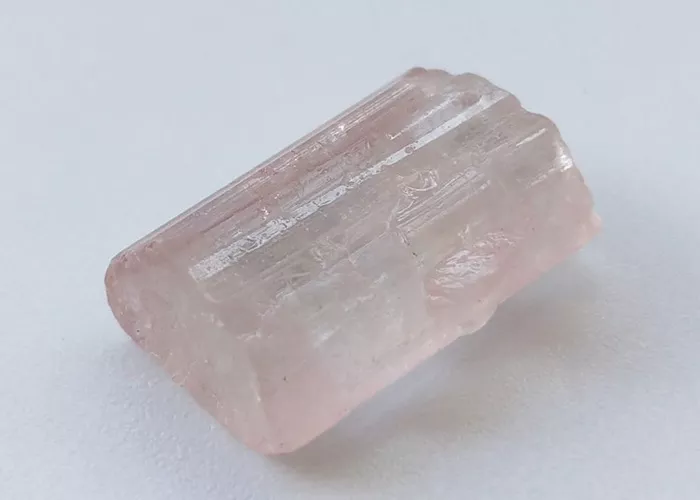In the vast realm of gemstones, pink tourmaline stands out for its unique charm and captivating beauty. This article delves into the fascinating world of pink tourmaline, with a particular focus on its intriguing UV reactive properties. Whether you’re a seasoned collector, a jewelry enthusiast, or simply someone curious about the natural world, this guide will provide comprehensive insights into this remarkable gemstone.
Understanding Pink Tourmaline
Basic Characteristics
Pink tourmaline belongs to the tourmaline family, which is one of the most complex and fascinating groups of gemstones. Tourmaline is a silicate mineral with a complex crystalline structure that gives it its unique properties. It is found in a wide range of colors, from deep reds and greens to soft pinks and blues, making it a highly versatile gemstone for jewelry creation.
Pink tourmaline, specifically, is valued for its delicate and romantic hue, which can range from soft blush pinks to vibrant hot pinks. This coloration is often the result of trace elements present in the mineral during its formation, such as manganese and titanium.
Formation and Occurrence
Pink tourmaline forms under specific geological conditions, typically in pegmatites, which are large, coarse-grained igneous rocks. These rocks can be found in various locations around the world, including Brazil, Madagascar, and the United States. The mineral-rich environment of pegmatites provides the ideal conditions for the formation of tourmaline crystals, which can grow to impressive sizes.
The process of tourmaline formation involves the crystallization of silicate minerals from a magma or volcanic ash. Over millions of years, these crystals undergo various transformations and are eventually exposed by erosion and weathering. Once discovered, they are carefully mined and processed to reveal their stunning beauty.
The UV Reactive Phenomenon
What is UV Reactivity?
UV reactivity refers to a gemstone’s ability to emit light or change color when exposed to ultraviolet (UV) radiation. This phenomenon is common in a variety of minerals and gemstones, including some types of tourmaline. UV reactive gemstones often have a unique glow or luminescence when viewed under UV light, making them particularly intriguing to collectors and scientists.
Mechanisms Behind UV Reactivity
The UV reactive properties of pink tourmaline are the result of various factors, including its chemical composition and crystalline structure. Tourmaline contains trace elements and impurities that can absorb UV light and then re-emit it as visible light. This process is known as fluorescence or phosphorescence, depending on whether the emitted light persists after the UV source is removed.
Fluorescence occurs when the absorbed UV light excites electrons within the mineral’s crystal structure. These excited electrons then return to their ground state, releasing energy in the form of visible light. The color of this emitted light depends on the specific impurities and defects within the crystal.
Types of UV Reactivity
Pink tourmaline can exhibit different types of UV reactivity, ranging from subtle glows to bright, vivid colors. Some pink tourmalines may show a soft, pastel glow under UV light, while others may exhibit more intense and vibrant colors. The intensity and color of the UV reaction can also vary depending on the specific lighting conditions and the gemstone’s cut and clarity.
Identifying and Evaluating UV Reactive Pink Tourmaline
Testing for UV Reactivity
To determine if a pink tourmaline is UV reactive, it can be tested using a UV light source, such as a blacklight or UV flashlight. When exposed to UV light, the gemstone should exhibit some form of luminescence or color change. It’s important to note that not all pink tourmalines will react to UV light, and the intensity and color of the reaction can vary widely.
Factors Affecting UV Reactivity
Several factors can influence the UV reactive properties of pink tourmaline. These include the gemstone’s chemical composition, the presence of impurities and defects, and its treatment history. Some pink tourmalines may have been treated to enhance their color or clarity, which can affect their UV reactivity.
When evaluating the UV reactivity of a pink tourmaline, it’s essential to consider its overall quality and characteristics. A well-cut, clear gemstone with minimal treatments is likely to exhibit more intense and vivid UV reactivity than one with lower quality or more extensive treatments.
Collectors’ Perspective
For collectors and enthusiasts, UV reactivity can be a fascinating aspect of pink tourmaline ownership. Many collectors enjoy experimenting with UV light sources to discover the unique glows and colors of their gemstones. This can add a layer of excitement and discovery to the hobby, making each piece even more special and unique.
Practical Applications of UV Reactive Pink Tourmaline
Jewelry Design
UV reactive pink tourmaline can be a striking addition to any jewelry collection. Its unique glow under UV light can create a mesmerizing effect, making it an ideal choice for evening wear or special occasions. Many jewelers incorporate UV reactive gemstones into their designs, creating pieces that are both beautiful and intriguing.
Scientific and Educational Uses
Beyond jewelry, UV reactive pink tourmaline can also have practical applications in scientific and educational settings. Its luminescent properties can be used in mineralogy and geology classes to demonstrate fluorescence and phosphorescence. Researchers may also study the UV reactive properties of tourmaline to gain insights into its formation and composition.
Artistic Expressions
Artists and designers often incorporate UV reactive gemstones into their work, creating pieces that are both visually stunning and interactive. Pink tourmaline’s unique glow can be used to create dynamic and captivating light installations, sculptures, and other art forms.
Conclusion
In conclusion, pink tourmaline is a remarkable gemstone that combines beauty, rarity, and unique properties. Its UV reactive characteristics make it an especially intriguing choice for collectors, jewelers, and artists alike. Whether you’re drawn to its delicate pink hue or its mesmerizing glow under UV light, pink tourmaline offers a world of discovery and wonder.
Related topic:
- Is Black Tourmaline Good for Sleep
- What is Raw Tourmaline and Why is it So Popular?
- Pink Tourmaline VS Opal: What is The Difference?


